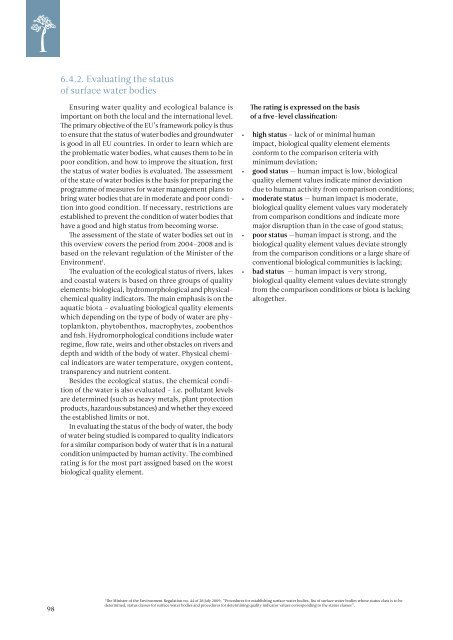ESTONIAN ENVIRONMENTAL REVIEW 2009
ESTONIAN ENVIRONMENTAL REVIEW 2009
ESTONIAN ENVIRONMENTAL REVIEW 2009
Create successful ePaper yourself
Turn your PDF publications into a flip-book with our unique Google optimized e-Paper software.
6.4.2. Evaluating the status<br />
of surface water bodies<br />
Ensuring water quality and ecological balance is<br />
important on both the local and the international level.<br />
The primary objective of the EU’s framework policy is thus<br />
to ensure that the status of water bodies and groundwater<br />
is good in all EU countries. In order to learn which are<br />
the problematic water bodies, what causes them to be in<br />
poor condition, and how to improve the situation, first<br />
the status of water bodies is evaluated. The assessment<br />
of the state of water bodies is the basis for preparing the<br />
programme of measures for water management plans to<br />
bring water bodies that are in moderate and poor condition<br />
into good condition. If necessary, restrictions are<br />
established to prevent the condition of water bodies that<br />
have a good and high status from becoming worse.<br />
The assessment of the state of water bodies set out in<br />
this overview covers the period from 2004–2008 and is<br />
based on the relevant regulation of the Minister of the<br />
Environment I .<br />
The evaluation of the ecological status of rivers, lakes<br />
and coastal waters is based on three groups of quality<br />
elements: biological, hydromorphological and physicalchemical<br />
quality indicators. The main emphasis is on the<br />
aquatic biota – evaluating biological quality elements<br />
which depending on the type of body of water are phytoplankton,<br />
phytobenthos, macrophytes, zoobenthos<br />
and fish. Hydromorphological conditions include water<br />
regime, flow rate, weirs and other obstacles on rivers and<br />
depth and width of the body of water. Physical chemical<br />
indicators are water temperature, oxygen content,<br />
transparency and nutrient content.<br />
Besides the ecological status, the chemical condition<br />
of the water is also evaluated – i.e. pollutant levels<br />
are determined (such as heavy metals, plant protection<br />
products, hazardous substances) and whether they exceed<br />
the established limits or not.<br />
In evaluating the status of the body of water, the body<br />
of water being studied is compared to quality indicators<br />
for a similar comparison body of water that is in a natural<br />
condition unimpacted by human activity. The combined<br />
rating is for the most part assigned based on the worst<br />
biological quality element.<br />
The rating is expressed on the basis<br />
of a five-level classification:<br />
• high status – lack of or minimal human<br />
impact, biological quality element elements<br />
conform to the comparison criteria with<br />
minimum deviation;<br />
• good status — human impact is low, biological<br />
quality element values indicate minor deviation<br />
due to human activity from comparison conditions;<br />
• moderate status — human impact is moderate,<br />
biological quality element values vary moderately<br />
from comparison conditions and indicate more<br />
major disruption than in the case of good status;<br />
• poor status —human impact is strong, and the<br />
biological quality element values deviate strongly<br />
from the comparison conditions or a large share of<br />
conventional biological communities is lacking;<br />
• bad status — human impact is very strong,<br />
biological quality element values deviate strongly<br />
from the comparison conditions or biota is lacking<br />
altogether.<br />
98<br />
I<br />
The Minister of the Environment Regulation no. 44 of 28 July <strong>2009</strong>, “Procedures for establishing surface water bodies, list of surface water bodies whose status class is to be<br />
determined, status classes for surface water bodies and procedures for determining quality indicator values corresponding to the status classes”.

















